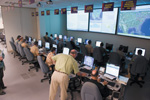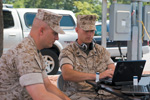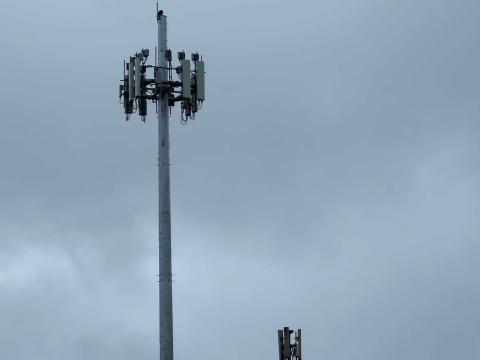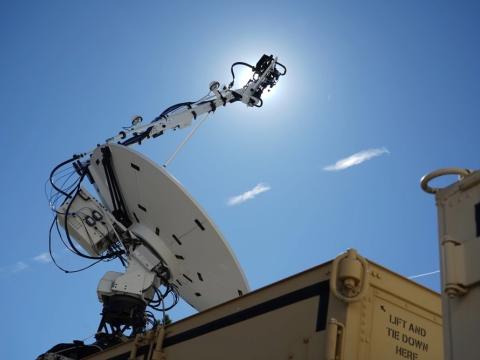Demonstration Drives Disruptive Technologies
 |
Contractors and military personnel collaborate, command and control from enclave one at the JFCOM Suffolk complex during CWID. |
Against a backdrop of current events, warfighters participating in the Coalition Warrior Interoperability Demonstration took the controls and toyed with tools that future troops may one day find indispensable. The activities in which to explore more than 40 emerging or improved capabilities were based not only on operations in
From locations around the world, participants from more than 20 countries stayed connected via three networks during a two-week demonstration. They explored nearly 50 technologies that spanned the spectrum from some that were hot off the drawing board to others that would bring new functionality to current systems. While it is too early to say which will move forward in the acquisition process and which will fall by the wayside, participants predict that, once fully developed, some could become disruptive technologies that truly are game changers.
The U.S. Joint Forces Command (JFCOM),
Capt. Kirk Hornburg, USN, served as the commanding general for the combined task force (CTF) at this year’s event. Although this is the first time he participated in CWID, Capt. Hornburg’s experience with numerous other exercises and experiments, both in the
The captain shares that he was surrounded by a motivated group of warfighters at the
“One of the differences this year that incredibly stood out was that Gen. Mattis gave the dictate that we were going to work a real-world scenario,” Capt. Hornburg shares. Participants were addressing challenges raised in
Concerning ground operations, CWID participants were examining capabilities that would support communications when facing crises such as a missile launch or improvised explosive device (IED) placement. The captain explains that they were exploring how technical solutions would support reporting and communicating incidents as well as how this information could be localized within command and control (C2) systems and marked on mapping systems. For scenarios concerning intelligence sharing when terrorists are observed placing IEDs in an area, the JFCOM CWID staff worked with Combined Forces Special Operations Commander (CFSOC) personnel, the captain adds.
On the maritime side, notional coalition forces were operating off the Horn of Africa, where they were boarding ships and investigating cargo. “On one hand, this scenario had an artificiality about it that talks about boarding a ship to investigate cargo. Well, I can look at open-source material today, and it discusses tracking a North Korean ship that we were contemplating. So the scenarios are not anything that we are stretching at all,” Capt. Hornburg says.
For the air scenarios, CWID participants were using both current systems that first were introduced in CWID a few years ago and are now being used in the field. Event teams were exploring additional functionality, as well as looking at new tools that have not been used before.
The captain points out that operations variety in CWID also was important. In addition to strictly military operations, the demonstration explored how technologies can be used in civil-military as well as homeland defense/homeland security operations. “Particularly on the CTF staff, I was tracking not only what the people on my immediate staff were doing, I was getting reports from the U.K. folks about what they were doing in the work on the Kajaki Dam in Afghanistan. That’s about as real world as it gets,” he offers.
Reality brought some richness to the event, Capt. Hornburg says. With the help of Special Operations Command–JFCOM, toolsets were tested beyond the set scenarios. While exploring the technologies, free play led to participants contributing their own experiences. They shared how they would track IEDs and missile launches in real-world operations, pointing out the types of toolsets they would need. These technologies would include chat capabilities and an operational means of notification, using C2 systems, to share information up the chain of command to get a decision, the captain relates.
The varied background of CWID participants also contributed to the depth of the event. For example, Capt. Hornburg assigned Lt. Cmdr. Rob Roscoe, RN, as his C-3. The lieutenant commander expressed doubt about whether he could handle the job. However, Capt. Hornburg quickly pointed out to him that during real-world operations, oftentimes members of a CTF are placed in positions that they may not feel qualified to fulfill. In this case, having this representative from the
 |
While participating in CWID, Sgt. Michael Phillips, USMC (r), and Staff Sgt. Christopher Nash, USMC, configure a field deployable cellular network using commercially available components. |
In this complex environment, Capt. Hornburg found a number of capabilities that piqued his interest. One such item was the Classification, Stateless Trusted Environment (CSTE), which the U.S. Special Operations Command (SOCOM) developed and demonstrated. The captain shares that during the first few days of the event, participants did not quite understand the power of this tool. As is often the case, technology users found it easier to default to the tools that they were most comfortable using rather than to explore the new and additional capability a solution brings. However, once they had the opportunity to work with the CSTE, participants began to understand its true value.
To demonstrate the tool, SOCOM included a chat capability as well as document transfer and library tools. “We mistakenly focused our attention on the chat and the transfer tools rather than realizing what was really going on: the security control underneath. By about the third day, we started playing with it enough that we began to understand what the demonstration was really about. We started going back and asking SOCOM and their representatives about what drives this [environment]. Then, we immediately started going beyond the scenarios we had been given into some pretty aggressive free play, which resulted in free playing not just within our site, but then across to Dahlgren and elsewhere,” Capt. Hornburg notes. The
The CSTE enables users to encapsulate information and distribute it to specific groups easily. CWID participants worked with many other cross-domain chat tools that addressed permission to view data, but this tool enables users to classify information into numerous subsets. The permissions that a user creates go a long way to enable the military to work with intelligence information, the captain explains. Other demonstrations addressed the same issue, including the ability to classify chat session and wiki material, he adds.
As a result of what he saw at CWID, the captain predicts that the CSTE will be a truly disruptive technology. “Without a CWID, it might have been something I would have taken a casual look at or would have just walked right by at a trade show or elsewhere,” he states. Likewise, without the chance to have hands-on use of the tool, the CSTE was the type of solution he may have misunderstood in terms of what underlies it, the captain adds.
SOCOM representatives demonstrating the CSTE were the first to admit that the environment still requires some tweaking; however, they were excited to have warfighters work with it because this helps them determine which direction to go next in development, the captain shares.
The benefit of insight from users also is available for the vendors who participate in CWID, Capt. Hornburg notes. Companies often present their solutions to members of the government in the form of PowerPoint presentations, but this approach does not always give potential users a true picture of a technology’s capability. For example, a capability may work beautifully when demonstrated from one cubicle to the next, but may not offer the same benefits once it is put into a larger environment. CWID, on the other hand, enables developers to demonstrate that their solutions will work over a broad area.
“Oftentimes, what is revealed is not that the tool doesn’t technically perform the way it was designed, but that the design itself may be challenged by the way that we work with it operationally. I hope that comes across clearly. It really is fundamentally important that, at times, the interaction of a staff relates a flaw in how we use the tools that supersedes the technical proficiency of the tool, particularly with command and control,” Capt. Hornburg says.
To obtain these insights, it is particularly important that developers who choose to participate in the event come well prepared. The captain warned those demonstrating technologies that he would be upfront and honest in his evaluation, and he says he kept that promise. Over the duration of the event, it became obvious which contractors and government personnel working particular demonstrations spent a lot of time preparing their demonstrations ahead of time and who showed up just in time. “When I look at the amount of effort and taxpayer dollars that are spent, this is a great opportunity to test drive toolsets across multiple staffs rather than testing it from one cubicle to another. … To do that, what is owed in return to the staff that is going to test it and the people who are going to do the assessment is [technology demonstrators who are] ready to go. That means there were some people who were better than others in being prepared,” Capt. Hornburg says.
The captain’s critique is not meant maliciously but rather offered as a sincere word of advice to technology developers who plan to participate in CWID in the future. “Know this is an astounding opportunity to show off your toolset. If you are going to come here, there are a lot of people who didn’t get invited and who sat home that certainly could have exploited the opportunity a little better,” he states.
WEB RESOURCE
Coalition Warrior Interoperability Demonstration: www.cwid.js.mil/c/extranet/home




Comments